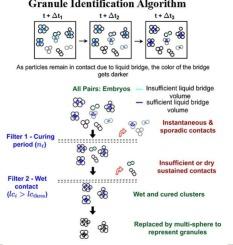流化床造粒机的CFD-DEM建模:颗粒的形成、识别和颗粒尺寸分布的演变
IF 4.6
2区 工程技术
Q2 ENGINEERING, CHEMICAL
引用次数: 0
摘要
本研究采用CFD-DEM耦合方法对干湿球形颗粒的稀疏伪二维流化床中的湿造粒过程进行建模。通过计算颗粒固化时间和表面液体含量,采用一种新的颗粒识别算法对颗粒相互作用形成的颗粒进行量化。已识别的颗粒被多球模型取代,以纳入由于液桥干燥而导致的颗粒强化效应。分析了颗粒尺寸分布的时间演变,并研究了关键工艺参数,包括表面气速、液体粘结剂性能(如液体含量、粘度和表面张力)和固化时间的影响。在研究的各种因素中,发现液体粘合剂表面张力和表面气速是最强的因素。粘度似乎没有发挥显著的作用,可能是由于使用粗粒度的颗粒。本文章由计算机程序翻译,如有差异,请以英文原文为准。

CFD-DEM modeling of fluidized bed granulator: Granule formation, identification, and evolution of granule size distribution
The present study adopts a CFD-DEM coupled approach for modeling the wet granulation in a sparse pseudo-2D fluidized bed of dry and wet spherical particles. The granules formed through particle interactions are quantified using a novel granule identification algorithm, by accounting for the particle curing period and the surface liquid content. The identified granules are replaced by a multi-sphere model to incorporate the effect of granule strengthening due to drying of the liquid bridge. The temporal evolution of granule size distribution is analyzed, and the effects of key process parameters, including superficial gas velocity, liquid binder properties (such as liquid content, viscosity, and surface tension), and curing period, are investigated. Among various factors explored, the liquid binder surface tension and superficial gas velocity are found to be the strongest factors. Viscosity does not seem to play a significant role, possibly due to the use of coarse-grained particles.
求助全文
通过发布文献求助,成功后即可免费获取论文全文。
去求助
来源期刊

Powder Technology
工程技术-工程:化工
CiteScore
9.90
自引率
15.40%
发文量
1047
审稿时长
46 days
期刊介绍:
Powder Technology is an International Journal on the Science and Technology of Wet and Dry Particulate Systems. Powder Technology publishes papers on all aspects of the formation of particles and their characterisation and on the study of systems containing particulate solids. No limitation is imposed on the size of the particles, which may range from nanometre scale, as in pigments or aerosols, to that of mined or quarried materials. The following list of topics is not intended to be comprehensive, but rather to indicate typical subjects which fall within the scope of the journal's interests:
Formation and synthesis of particles by precipitation and other methods.
Modification of particles by agglomeration, coating, comminution and attrition.
Characterisation of the size, shape, surface area, pore structure and strength of particles and agglomerates (including the origins and effects of inter particle forces).
Packing, failure, flow and permeability of assemblies of particles.
Particle-particle interactions and suspension rheology.
Handling and processing operations such as slurry flow, fluidization, pneumatic conveying.
Interactions between particles and their environment, including delivery of particulate products to the body.
Applications of particle technology in production of pharmaceuticals, chemicals, foods, pigments, structural, and functional materials and in environmental and energy related matters.
For materials-oriented contributions we are looking for articles revealing the effect of particle/powder characteristics (size, morphology and composition, in that order) on material performance or functionality and, ideally, comparison to any industrial standard.
 求助内容:
求助内容: 应助结果提醒方式:
应助结果提醒方式:


